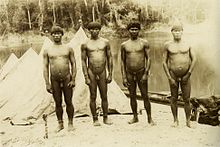Mehinako
The Mehinako (also Mehináku, Meinacos ) are an indigenous Indian tribe who live in Parque Indígena do Xingu in the central Brazilian region of Alto Xingu in the Brazilian part of the Amazon basin . The population was given in 2014 as 286 Indians (according to Siasi / Sesai)
The Mehinako language, Mehináku , is one of the Arawak languages .
history
It is believed that the Xingu region has long been the settlement area of the Mehinako. The first traces of a settlement by the Mehinako can be found in the settlement Yulutakitsi, which was founded by the Mehinako at the latest around 1850. During an expedition by the German explorer Karl von den Steinen in 1884, the Mehinako had three villages. In the 1950s, the Mehinako had to leave these settlements because they had been driven out by the Ikpeng , an indigenous tribe with Caribbean roots. In the battle with the Ikpeng, the chief of the Mehinako was hit by an arrow. The Mehinako then withdrew and settled on the Tuatuari, a tributary of the Rio Culuene . The Yawalapiti , another indigenous tribe, had already settled there. After the two tribes had reached an agreement, among other things in the field of fishing in the Tuatuari, they lived peacefully side by side. After a series of epidemics, the Mehinako founded a new village about 200 meters from their previous place of settlement. Relations with the Yawalapiti intensified in the following decades, which can be traced back to several weddings between members of the tribes and similar tribal rituals.
The relationship between the Mehinako and the whites is ambivalent. In the mythology of the tribe, the Mehinako and the White are sons of the sun, with the whites receiving special abilities as gifts from the sun. For the indigenous people, whites are also a symbol of disease. Nevertheless, the Mehinako strive to maintain good relations with the whites.
See also
literature
- Thomas Arthur Gregor: Mehinaku: The drama of daily life in a Brazilian indian village. University of Chicago Press, Chicago 1977. ( Digitized version of the Portuguese-language edition: Mehináku , 1982; PDF, 6 MB).
- Maria Heloísa Fénelon Costa: O mundo dos Mehináku e suas representações visuais. UnB, Brasília 1988.
Web links
- Mehinaku , website Povos Indígenas no Brasil of the Instituto Socioambiental (English, Brazilian Portuguese)
- Artifacts of the Mehináku in the Museu do Índio , Rio de Janeiro
Individual evidence
- ↑ Mehinaku on the website of Ethnologue . Accessed May 31, 2019.
- ↑ Angel Corbera Mori: Aspectos da morfofonologia e morfologia nominal da língua Mehinaku (Arawak). In: Bruna Franchetto (Ed.): Alto Xingu. Uma sociedade multilíngue . Museu do Índio, FUNAI, Rio de Janeiro 2011, ISBN 978-85-85986-34-6 , pp. 193-216 (Brazilian Portuguese, academia.edu ).
